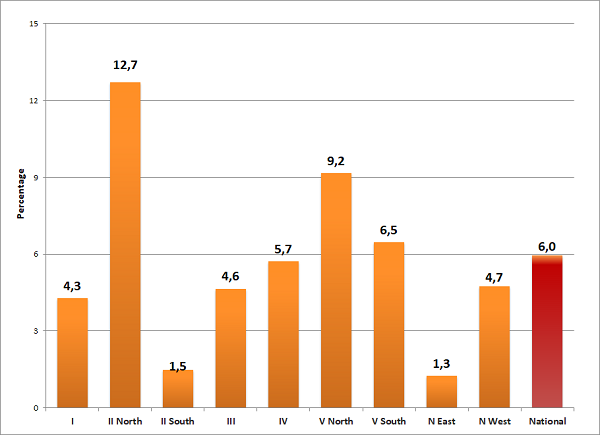 INTRODUCTION
INTRODUCTIONWHEAT
Triticum aestivum L.
| |||||||||||||||||||||||||||||||||||||||||||||||||||||||||||||||||||||||||||||||||||||||
National production is estimated at 19,454 million tons, slightly up from the previous season that reached 18,445 million tons. Six thousand two hundred ninety-one (6,291) million hectares were planted, and 6,037 were harvested. The national yield was 3,222 kg/h, quite similar to the 3,124 kg/h of the previous growing season.
Once again, yellow rust was the prevalent foliar disease. The province of Buenos Aires, especially in southeastern latitudes, was the most infected. The disease occurred to a much lesser extent in the center and west of the province, considering the significant moisture stress suffered in the area. Yellow spot and bacteriosis were detected in regions where frost damaged the crop. Other endemic diseases such as leaf rust were of secondary importance due to the extent of yellow rust infection. Stem Fusarium was as relevant as yellow rust but only in particular areas. (Information supplied by Dr. Pablo Campos). The occurrence of Fusarium was low and distributed in the Pampeana Centro subregion (that is, south of Cordoba, south of Santa Fe, center and north of Buenos Aires). In 9 de Julio, Pehuajo, Bolivar, and Dolores (that is, in the center of the province of Buenos Aires), moderate to severe Fusarium infection was reported at mid and late heading dates. In the Northern part of the Pampeana Norte subregion (that is, Entre Rios, center and north of Santa Fe and Cordoba), the occurrence of Fusarium was low. Moderate and high degrees of Fusarium occurrence was reported only in the center east of Entre Rios; the infection affected wheat with early heading dates.
SAMPLING STRUCTURE
It was agreed to take representative samples of about 4,000 tons. In total, 264 analyses. Sampling was based on areas planted in each county or department and average yields from the three last seasons, following data from the Federal Ministry of Agribusiness. The resulting estimated production was the basis to determine the number of samples to take by country or department. The idea was to have a proportional representation from each locality.
The Argentine Association of Cooperatives (ACA), the Federation of Storage Centers and Grain Handlers’ Union Entities of the Argentine Republic, Argentine Federated Farmers and the Argentine Federation of Flour Mills, through their cooperatives, storing facilities and mills contributed commercial samples that were used to create samples by locality, following instructions timely sent.
Furthermore, the Agriculture and Forestry Directorate of the Ministry of Agribusiness supported the sampling and logistics.
| |||||||||||||||||||||||||||||||||||||||||||||||||||||||||||||||||
These primary samples had to represent between 100 and 250 ton, and be selected so they reflected the zone production conditions as well as possible, being 3729 samples used for this sampling program, in such a way a sampled tonnage of 6,0 % of the national wheat production, which amounted to 19.454.159 tons, was reached
|








